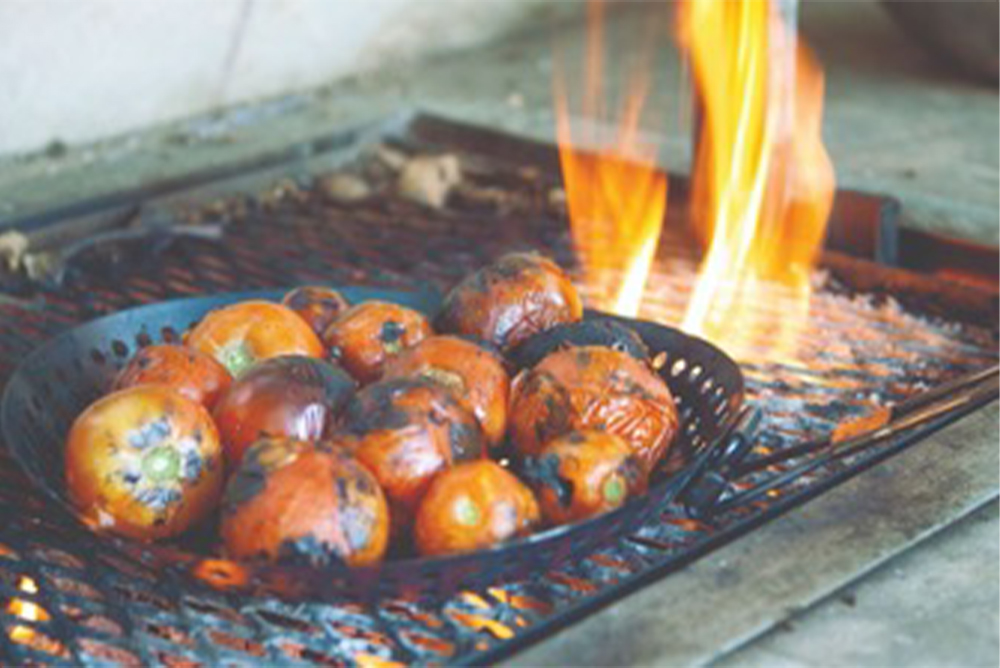
This tomato season, read chef Evan Rilling’s guide to unlocking the magic of the nourishing fruit. Courtesy of author.
Food can connect us to the earth, our community, and ourselves. But first, we need to open a space to listen to and be in exchange with the ingredients.
As a professional chef, I have spent years learning to do this with the plants I grow and cook with. This practice has profoundly changed the way I think about my work and the world around me.
Looking back, one of my most important teachers on this journey, in the kitchen and in life, was the tomato.
Growing up, I struggled with my relationship to this beautiful plant and its magic fruit, even as I found myself drawn to it. It was only after I learned how to truly listen to tomatoes and give them what they need to thrive, that I experienced the true magnificence, amazing flavors, and powerful energy they have to share with us all.
The first dish I ever learned how to make was salsa. I was 5 years old, and I can still remember picking the juicy tomatoes, serrano chilies, and fragrant cilantro from my parents’ garden in Ojai, the Southern California valley at the base of the Topatopa Mountains. I kept tasting the salsa over and over again, adding a little more chili, then a little more salt, then a little more lemon. Adjusting and experimenting with the balance of flavors until it tasted just how I wanted it: delicious.
But a tomato on its own? That grossed me out. Now I know that the culprit was store-bought tomatoes—pink, mealy, store-bought tomatoes. I still cringe when I think about their watery, bland flavor. The worst were the slices that sat goopy and soggy in my sandwich, waiting to be eaten in my lunchbox at school.
What I didn’t realize then was that these weren’t a proper reflection of the tomato family. They were the industrialized representatives. There are actually more than 10,000 types of tomatoes out there—way more than the two to three varieties you see in the average grocery store.
The revelation that there was a whole other world of tomatoes out there came to me when I went away to San Diego for college and started working at my first fine-dining restaurant, NINE-TEN. I’ll never forget the heirloom tomato salad on their menu. Who knew tomatoes came in so many colors and variations? I took my first bite, and the bright, sweet, sharp flavors of their tomatoes opened my eyes to what high-quality ingredients can do for a meal, and how limited my understanding of the plant had been up to that point.
After college, I returned to Ojai, where I got focused on growing my own food. With my mom as my mentor and advisor, I started to develop a deeper relationship with plants, and saw how they could thrive when they received the love and nutrients they needed.
The work thrilled me. Every morning, I woke up early to check on the land, inviting friends to come and garden with me. We planted all kinds of vegetables in the beautiful soil we created by composting our food and garden scraps.
Through gardening, I learned that all food needs good food and good vibes to flourish. The same can be said for humans. For years I hadn’t been taking my health as seriously as I should have, and it was around this time that I realized I needed to make some drastic changes myself if I wanted to feel strong and capable in my body and keep doing the things I loved—like surfing, playing in nature, and growing my garden.
At this point, I had been growing over 40 varieties of heirloom tomato plants. I had been so excited to see them fruit, and find out what it would be like to cook with them and how they would taste. Unfortunately, after a few weeks of chowing down on them, my chiropractor recommended that I take a break from eating plants from the nightshade family, as they can be inflammatory.
It was a total bummer to stop eating tomatoes after we’d come so far together, but by overindulging in them and then cutting them out of my diet, I actually became even closer to tomatoes. The experience taught me to listen to my body and find out how to develop a healthier relationship with the plant that worked for me. I can now eat tomatoes freely when it feels good for me to and know when to stop when I need to. I recommend this exact method to clients who really want to understand how food affects them. It’s true, I tell them, after you take some time away from an ingredient, try going all in if you truly want to understand how the food is affecting you. Even junk food: I dare you to eat a whole bag of Doritos and see how you feel! I bet you won’t be going back for seconds.
I am grateful to tomatoes for all of the gifts they’ve shared and the lessons they’ve taught me, and am honored to now share these teachings with you.
Here’s how anyone can connect to ingredients in a deeper way:
First, choose an ingredient that you feel called to and would like to build a stronger connection with.
Then place the ingredient in front of you. Look at it. What did you see?
Touch it. What did you feel?
Listen to it. What did you hear?
Smell it. How would you describe it?
Taste it. How would you describe the experience?
How have you worked in harmony with it?
How could you work in harmony with it?
These teachings will expand your abilities and awareness of what you eat.
Developing your own relationship with any plant or ingredient—whether you’re cooking, gardening, applying a wellness technique, or working with them for healing—can be powerful, not to mention fun.
But before you try this process, I invite you to take a moment, center yourself, and let yourself be open to the possibilities that may present themselves to you. Because by letting yourself truly connect and listen to a plant, you may find it has many lessons for you, just like the tomato has had for me.





Send A Letter To the Editors